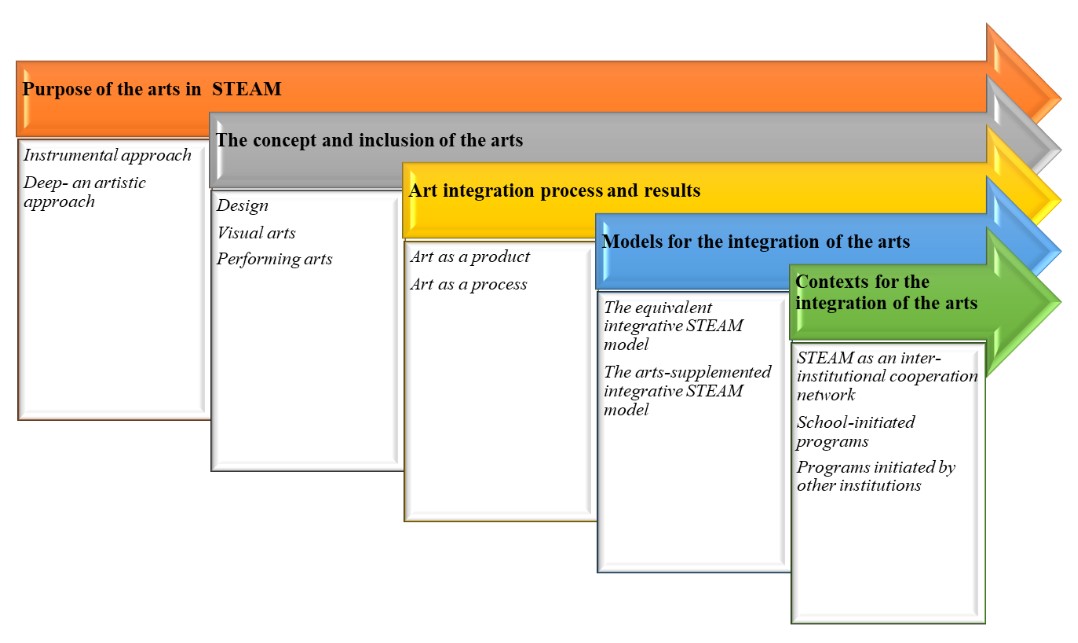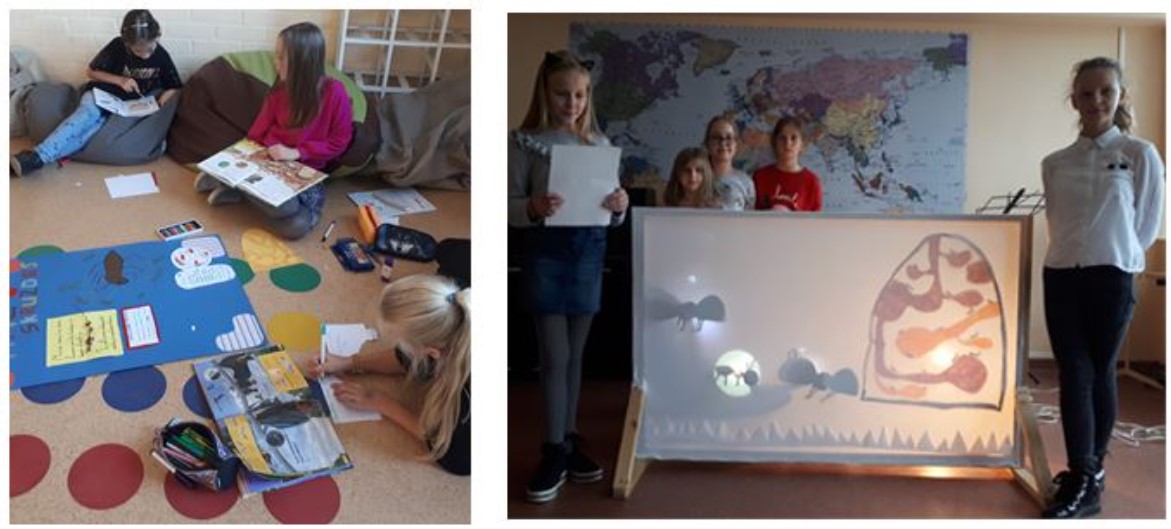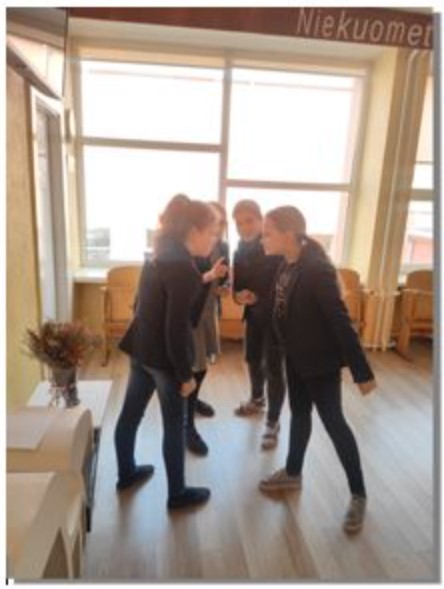3 Transformation of STEM to STEAM education
In this chapter you learn about:
- What are the expectations associated with the addition of “A”?
- What are the ”A” interpretations: from creativity through the arts to the humanities and social sciences?
- What are the opportunities for art inclusion in STE(A)M?
The expectations of STEAM
The arts only became an integral part of STEM education at the beginning of the 21st century, when the integration of STEM subjects did not work as expected. STEAM has become an alternative to the classical STEM model (Costantino, 2018; Perignat & Katz-Buonincontro, 2019; Yakman, 2008). The inclusion of the arts was expected to make the educational process and its results innovative (Costantino, 2018; Hansen, 2014), stronger motivation of students to learn (Hunter-Doniger, 2018), acquisition of diverse experiences (Allina, 2018), wider applicability of STEAM programs (Knochel, 2018).
The STEAM concept emphasizes the aspect of creativity as a factor in creating a learning-friendly environment (Hunter-Doniger et al., 2018), a way to develop creative and critical thinking (Peppler & Wohlwend, 2018), and a prerequisite for developing communication and collaboration skills (Maeda, 2013). One of the reasons for the transformation of STEM education into STEAM was the abundance of research conducted at the end of the last century showing the impact of the arts and creativity on students’ academic achievement (Welch, 2011). Recognising that the arts (art education) improve achievement in mathematics and language arts, the arts have been included in STEM curricula. On the other hand, arts and creativity education have been linked to better PISA scores, problem-solving and critical thinking skills, teamwork, change management, collaboration, and other personal qualities that are highly valued in today’s job market.
Emphasis is placed on the playfulness of art practitioners and creative activities, the experience of risk-taking and the courage to make a mistake, the improvisational nature and the compatibility of meaningful activities in STEAM education.
The Letter “A” as the arts
In the last decade, a lot of attention has been paid to the issues of arts integration in the STEAM concept. Analyzing the involvement of individual fields of art in STEAM education, it becomes clear that design and visual arts (photography, painting, watercolor, graffiti, sculpture, models, collage, origami) are most often used. It has been observed that these arts make research more inclusive and the results of research more publicly available and better understood by students and their parents (Costantino, 2018). Performing arts (music, theater, dance) are less frequently used in STEAM activities, although the potential of these arts to express abstract scientific ideas in a non-traditional way is recognized (Segarra et al., 2018). For example, dance can be a great way to interpret spatial and dynamic scientific phenomena (Payton et al., 2017), and music to explore acoustic environmental variables (Shatunoval et al., 2019).
The inclusion of arts in STEAM education is ambiguous because of the diversity of both the notions of the arts and interpretations of the purpose of arts integration. Arts in STEAM education are associated with the improvement of students’ academic performance, the development of students’ creativity, critical thinking, and cooperation skills, and thus highlighting the instrumental significance of arts education. The instrumental and internal concepts of the purpose of the arts are to be related to the equivalent and arts-supplemented integrative STEAM models (Figure 1).
The concept of the arts and its purpose in STEAM education is diverse. Art is understood as a tool to generate relevant research problems and topics (Costantino, 2018), to contribute to the improvement of academic student achievement (Payton, White, & Mullins, 2017), to creative and critical thinking of students (Peppler and Wohlwend, 2018), and collaboration capacity building (Knochel, 2018).
The following meanings of artistic practices are cited to substantiate the intrinsic, in-depth value of integrating the arts into STEAM curricula: greater emotional engagement (Perignat and Katz-Buonincontro, 2019); al., 2017; Hunter-Doniger et al., 2018), the opportunity to discover learning meanings, to look at objects and phenomena in a new way (Welch, 2011; Bang-Hee et al., 2017), to apply knowledge in a variety of ways that are acceptable to everyone (Hunter-Doniger, 2016), to experience a sense of wonder and discovery, to experiment with ideas, materials, objects (Glass and Colleen, 2016). According to Payton, White, and Mullins (2017), an artist will view a problem completely differently than an engineer. First of all, they will choose a person-oriented approach, they will see not only technological but also social meaning in scientific activity.
Representatives of this approach to the purpose of the arts argue that STEAM education must be organized in such a way that lessons are culturally important, calling such a concept of STEAM culturally responsible education (Hunter-Doniger et al., 2018). An in-depth understanding of the purpose of the arts can complement the ways of scientific cognition, encourage the raising and addressing of human existence: What does our work mean? What will this mean for others? What ideas do we want to convey to the solid? How will our work help people learn about the world and themselves? (Radziwill et al., 2015). Such questions, according to the authors, reveal a culturally meaningful, much broader than usual concept of the purpose of science and technology.

Figure 1. The Notion of Arts in STEAM education (Girdzijauskiene & Šmitiene, 2020).
There are different STEAM models:
- The equivalent integrative STEAM model (S+T+E+A+M). In this model, the content and means of teaching all subjects are treated as equally valuable, i.e. disciplines of mathematics, science, technology, engineering, arts. (Perignat & Katz-Buonincontro, 2019; Costantino, 2018 etc.). Integration methods are interdisciplinary and multi-subject. The several features are planning and implementing multidisciplinary STEAM programs, detailed descriptions of the STEAM programs, covers a period longer than several months (in some cases the whole academic year), multiple forms of recording learning outcomes.
Multidisciplinary or transdisciplinary, integration is characterized by a focus on the learner, their cognitive activity, learning through research, independent action and decision-making. (Perignat & Katz-Buonincontro, 2019; Costantino, 2018; Shatunoval et al., 2019; Hunter-Doniger et al., 2018).
2. The arts-supplemented integrative STEAM model (STEM+A). This model is based on the instrumental concept of the purpose of art. They are related to the diversification of students’ academic activities, supplementing the repertoire of students’ practical activities through drawing, singing, movement, dance, acting. (Knochel, 2018; Morgan ir Collett, 2018; How, Loong ir Hung, 2019). Integration methods are interdisciplinary, and so on. The several features are that the axes of integration become the subjects of natural sciences, short-term project as a main teaching-learning form, one (less often several) forms of recording learning outcomes, developing students‘ artistic and creative mindsets (Gülhan & Şahin, 2018; Peppler & Wohlowend, 2018; Ahn, 2015).
The expanding practices of STEAM
Nowadays, the practice of including the arts in STEM has expanded significantly. School communities seek and find a variety of the ways for the interdisciplinary and multidisciplinary integration of the arts. The experience brought by various transnational and national STEAM projects is very valuable in this search. Klaipėda Vydūnas Gymnasium community (Lithuania) actively implemented STEAM projects in school, participated in CASE (Creativity, Arts and Science in Primary Educations) community activities (http://www.project-case.eu/).
In these STEAM projects, great attention was paid to the involvement of various arts (art, dance, theater, etc.) in the study of natural cognition and mathematics. The CASE project proposes methods based on the IBSE (Inquiry Based Science Education Circle). It is a “science through art” principle of teaching and learning that encourages teachers and students to raise issues and make creative decisions. The school chooses the seven-step methodology of STEAM projects for the involvement of the arts: question, proof, analysis, explanation, aggregation, communication, reflection. The developed methodology enables learners to understand scientific concepts and phenomena, to develop cooperation and teamwork skills, creative and critical thinking skills. The main axis of activities becomes the search for the links between the interdisciplinarity of science and art, the promotion of interest in natural sciences, and the increase of involvement in learning.
Primary school students’ project “Who needs ants?”
Pupils recorded the data collected during the research, collecting scientific information by drawing and photographing, and presented the results of the research in the shadow theater (picture, https://www.svietimonaujienos.lt/meno-ir-mokslo-jungtys-steam-projektuose/).

Figure 2. The integrating arts and science in the primary school project “Who needs ants?” (Photos: Vydūnas Gymnasium, Lithuania)
In another project, the living conditions of spiders and their peculiarities were researched, the findings of the project were presented by slow-motion movie created by students, which was presented at the conference of Klaipeda University (Lithuania) (Figure 2; https://www.youtube.com/watch?v=qL32y-Rkfz8). In their research, students sought answers to the questions: Are all spiders venomous? Do spiders have feelings? The children were then divided into six groups. Each group chose one question that interested them the most.

Figure 3. Pupils explore the kingdom of spiders (Photos: Vydūnas Gymnasium, Lithuania)
Students had to come up with three characters (at least one of them had to be a spider) who had 3 and 2 bad qualities and 1 secret. They had to portray the chosen character, showing all the qualities and mystery. For this purpose, they used wallpapers – on the wallpapers they drew the outline of the child’s figure, students were encouraged to draw a character with assigned characteristics.

Figure 4. Sculpture method in STEAM project (Photo: Vydūnas Gymnasium, Lithuania)
The next step is to create a story using the accumulated knowledge of spiders. All stories were presented using the sculptural method, i. e. the “frozen” composition depicts three moments in history. Once all the stories were presented and discussed, students voted on which story they found most interesting.
As it can be seen from the previous examples, the multidisciplinary type of integration can fundamentally change the content of teaching / learning and the process of its implementation, i.e. encourage the abandonment of the traditional model of classroom education, learning only in classrooms or school settings. In many cases, the implementation of the program goes beyond the boundaries of one educational institution or curriculum. The main objective is to create a creative ecosystem to achieve the goals of STEAM (Radziwill et al., 2015).
References
Allina, B. (2018). The development of STEAM educational policy to promote student creativity and social empowerment. Arts Education Policy Review, 119(2), 77–87. https://doi.org/10.1080/10632913.2017.1296392
Colucci-Gray, L., Burnard, P., Gray, D., & Cooke, C. (2019). A critical review of STEAM (Science, technology, engineering, arts, and mathematics). In G. W. Noblit (Ed.), Oxford research encyclopedia of education. Oxford University Press. https://doi.org/10.1093/acrefore/9780190264093.013.398
Costantino, T. (2018). STEAM by another name: Transdisciplinary practice in art and design education. Arts Education Policy Review, 119(2), 100–106. https://doi.org/10.1080/10632913.2017.1292973
Friedl, A. (2017). Teaching science to children: An integrated approach. McGrow-hill collage.
Glass, D., & Wilson, C. (2016). The art and science of looking: Collaboratively learning our way to improved STEAM integration. Art Education, 69(6), 8–14. https://doi.org/10.1080/00043125.2016.1224822
Girdzijauskienė, R., & Šmitienė, G. (2021). The notion of arts in STEAM concept: A semi–systematic literature review. Pedagogika, 140(4), 155–171. https://doi.org/10.15823/p.2020.140.9
Hansen, M. (2014). Characteristics of schools successful in STEM: Evidence from two states’ longitudinal data. Journal of Educational Research, 107(5), 374–391. https://doi.org/10.1080/00220671.2013.823364
Hunter-Doniger, T. (2018). Art infusion: Ideal conditions for STEAM. Art Education, 71(2), 22–27. https://doi.org/10.1080/00043125.2018.1414534
Hunter-Doniger, T., Howard, C., Harris, R., & Hall, C. (2018). STEAM through culturally relevant teaching and storytelling. Art Education, 71(1), 46–51. https://doi.org/10.1080/00043125.2018.1389593
Yakman, G. (2008). STEAM education: An overview of creating a model of integrative education, the pupils’ attitudes towards technology (PATT-19). https://www.researchgate.net/publication/327351326_STEAM_Education_an_overview_of_creating_a_model_of_integrative_education. Conference: Research on Technology Innovation Design and Engineering Teaching.
Knochel, A. D. (2018). An object-oriented curriculum theory for STEAM: Boundary shifters, materiality and per(form)ing 3D thinking. International Journal of Education Through Art, 14(1), 35–48. https://doi.org/10.1386/eta.14.1.35_1
Liao, C. (2016). From interdisciplinary to transdisciplinary: An arts-integrated approach to STEAM education. Art Education, 69(6), 44–49. https://doi.org/10.1080/00043125.2016.1224873
Maeda, J. (2013). STEM +. Art = STEAM. The STEAM Journal, 1(1), 1–3. https://pdfs.semanticscholar.org/5d30/c4d0ffd67a4cd4d8ffbfa0eab32bf6ba8806.pdf
Morgan, D. L., & Scannell, A. (1998). Planning Focus Group as qualitative research. Sage publications Inc.. https://doi.org/10.4135/9781412984287
O.Nyumba, T., Wilson, K., Derrick, C. J., & Mukherjee, N. (2018) The use of focus group discussion methodology: Insights from two decades of application in conservation. Methods in Ecology and Evolution, 9(1), 20–32. https://doi.org/10.1111/2041-210X.12860
Payton, F., White, A., & Mullins, T. (2017). STEM majors, art thinkers (STEM + Arts) – Issues of duality, rigor and inclusion. Journal of Stem Education, 8(3), 39–47. https://www.jstem.org/jstem/index.php/JSTEM/article/view/2101/1870
Peppler, K., & Wohlwend, K. (2018). Theorizing the nexus of STEAM practice. Arts Education Policy Review, 119(2), 88–99. https://doi.org/10.1080/10632913.2017.1316331
Perignat, E., & Katz-Buonincontro, J. (2019). STEAM in practice and research: An integrative literature review. Thinking Skills and Creativity, 31, 31–43. https://psycnet.apa.org/doi/10.1016/j.tsc.2018.10.002. https://doi.org/10.1016/j.tsc.2018.10.002
Rufo, D. (2016). STEAM-ing up the science fair. Art Education, 69(4), 12–16. https://doi.org/10.1080/00043125.2016.1176475
Segarra, V. A., Natalizio, B., Falkenberg, C. V., Pulford, S., & Holmes, R. M. (2018). STEAM: Using the arts to train well-rounded and creative scientists. Journal of Microbiology and Biology Education, 19(1), 1–8. https://doi.org/10.1128/jmbe.v19i1.1360
Shatunoval, O., Anisimova, T., Sabirova, F., & Kalimullina, O. (2019). STEAM as an innovative educational technology. Journal of Social Studies Education Research, 19, 153–179. https://files.eric.ed.gov/fulltext/EJ1220702.pdf
Welch, G. F. (2012). The arts and humanities, technology and the “English Baccalaureate”: STEAM not STEM. Journal of Music, Technology and Education, 4(2), 245–250. https://doi.org/10.1386/jmte.4.2-3.245_1
